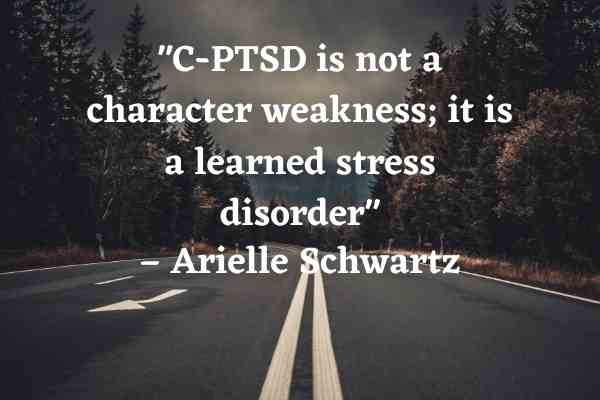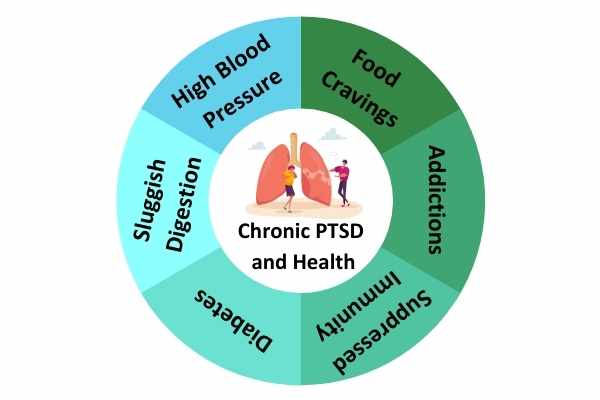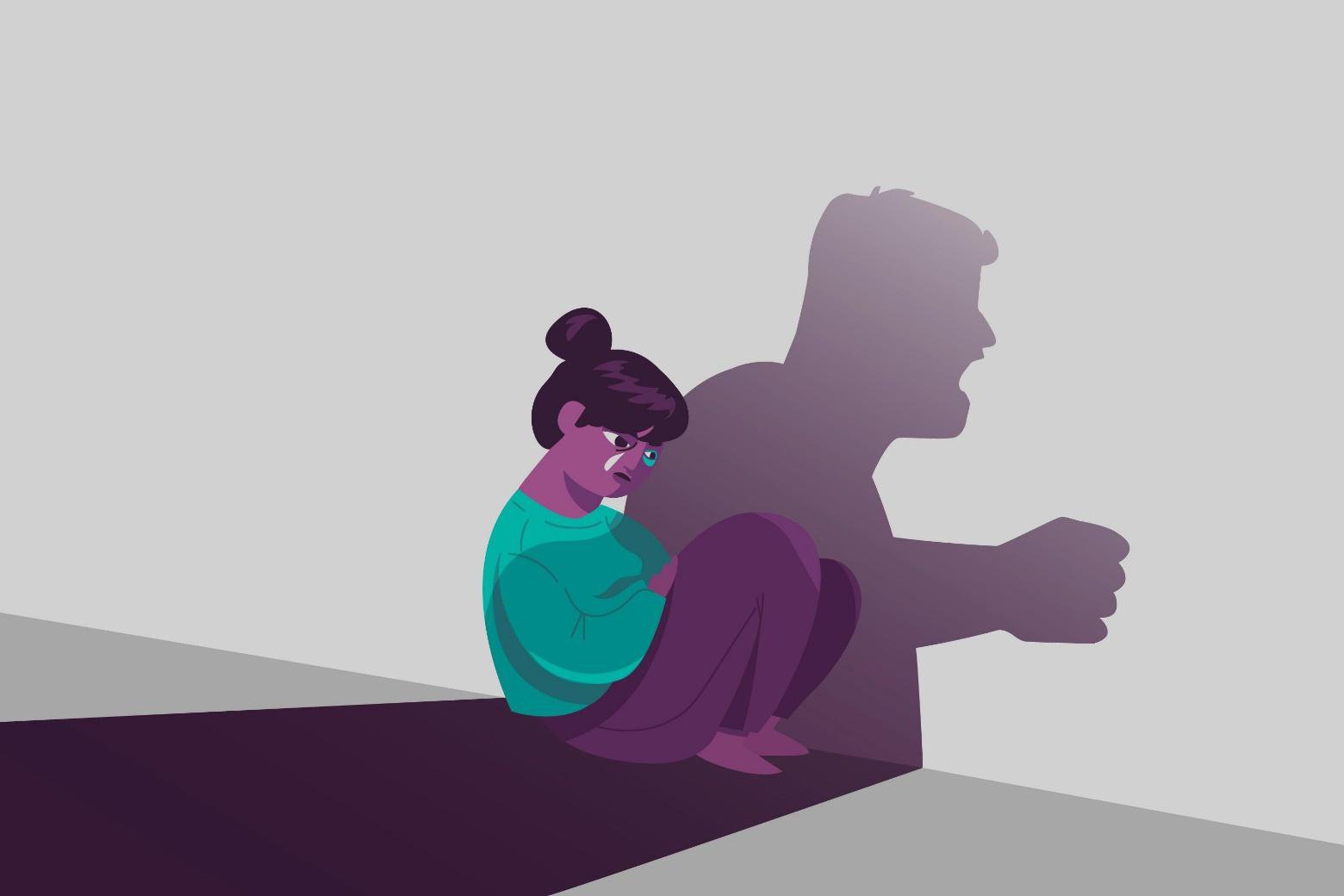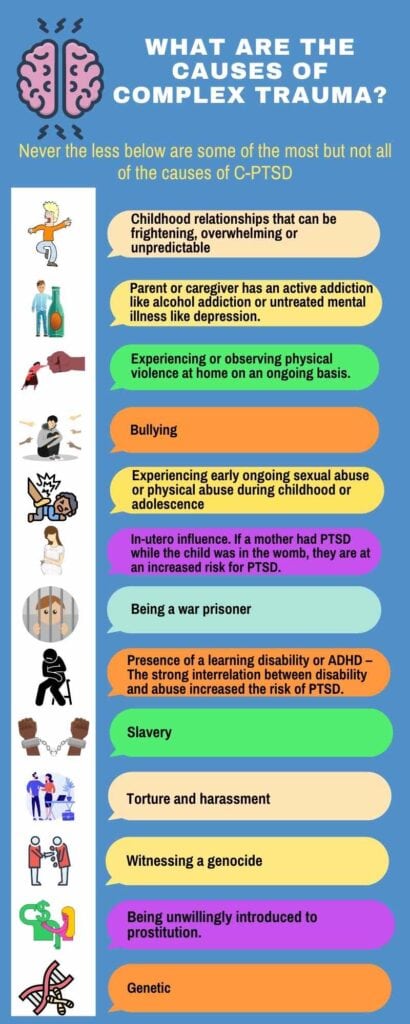“You are not broken and in need of fixing. You are wounded and in need of healing.” ― Danu Mor
PTSD or Post Traumatic Stress Disorder is usually associated with single traumatic events such as car accidents or natural disasters or acts of violence.
Complex post-traumatic stress disorder or abbreviated as C-PTSD, on the other hand, usually occurs due to exposure to long-term exposure to traumatic stress rather than any one single event.
C-PTSD typically arises due to ongoing stress or repeated traumatic events that occur during childhood and is sometimes also referred to as Developmental Trauma Disorder (DTD). In addition, C-PTSD usually occurs when childhood experiences include toxic parenting or untrustworthy parents or caregivers. As a result, one may continuously bear the burden of fear and lack of safety that may have originated in one’s childhood, but it continues to stay into adulthood.
Is C-PTSD Curable?
“C-PTSD is not a character weakness; it is a learned stress disorder” – Arielle Schwartz
Yes. The good news is that as adults, one need not stay with the emotional dysfunction. Instead, one can reclaim their life from childhood trauma. With empowerment and awareness, one can deepen their self-acceptance and reduce the difficult emotions like shame, anger, and sadness that often accompany childhood traumas.
Let’s understand C-PTSD in detail and how one can heal their inner psychological wound.
What Are the Symptoms Of C-PTSD?
Complex PTSD is a set of symptoms resulting from pain and stress that often begin at a very early age. These early experiences shape a person’s beliefs and perspectives for themselves, others and the world.
People may experience multiple symptoms that sometimes vary from person to person. Usually, if the trauma is experienced for a longer duration with high intensity, the greater the likelihood of developing C-PTSD.
The most common ones are listed below.
– The person may experience flashbacks and nightmares as his/her brain relives the trauma.
– While trying to forget, the person tends to stay away from situations or events that remind them of the terrifying event.
– When a C-PTSD remembers the trauma, they experience dizziness and sometimes even nausea.
– People who experience such terrifying events tend to be hyper-aroused. This simply means they are in a continued state of high alert.
– They tend to view the world as an unsafe place, especially for them.
– They lose trust in others and sometimes in themselves.
– They experience difficulty concentrating and sleeping.
– Sudden loud noises scare them very much.
– Depressive symptoms.
People diagnosed with C-PTSD may also experience some more uncommon symptoms:
- They view themselves differently, as weak, helpless and or even blame themselves for what happened to them.
- They change their view of the world or some beliefs they held before the trauma. They could lose faith in people or institutions they previously held in high regard, sometimes even religion.
- They may lose hold of their emotions, causing them to experience abnormal anger or sadness.
- Because of negative self-view, one may struggle fitting in a relationship as they feel unworthy. In addition, the lack of trust by a person suffering from C-PTSD may lead them to take too long to commit.
- When the person is unable to move on from the trauma, they end up getting their minds preoccupied with the event or person. They may even contemplate revenge.
Chronic PTSD And Health
Health problems associated with chronic stress where cortisol levels in the bloodstream are high, and immunity is low can include:
– High Blood Pressure
– Diabetes
– Food Cravings
– Sluggish Digestion
– Suppressed Immunity
What Are the Causes of Complex Trauma?
It is believed that C-PTSD is caused by severe and repeated trauma that lasted a long time.
For such a condition that results from different events happening to different people in different ways, every case is special, and this makes the list of causes endless. Nevertheless below are some of the most but not all of the causes of C-PTSD.
How To Identify If You Suffer From Complex-PTSD?
Some of the symptoms of Complex-PTSD are:
- If you experienced trauma or grief while very young.
- The experience lasted a long time.
- The possibility of escape or rescue was minimal.
- If you have experienced trauma more than once.
- The hostile situation was brought about by someone you know and trusted.
How To Treat Complex-PTSD?
Like I mentioned earlier, Complex trauma is treatable. It may seem extremely painful to take the path of unpacking the burdens of past trauma history. However, this is a route to profound self-care. Imagine one is creating more space by unloading the negative energy and emotions. The brain and body now has space for more positive emotions.
The unpacking of trauma needs to be paced to ensure it is not overwhelming for a person and they quit mid-way.
Let’s look at a few ways to unpack and off load C-PTSD.
EMDR Therapy

Eye Movement Desensitization and Reprocessing (EMDR) therapy is a brain-based psychotherapy. EMDR is widely researched to work effectively with past trauma memories. It helps to journey towards healing from the emotional dysfunction and distress related to the past experiences. EMDR therapy activates the brain’s information processing system to process past bad experiences and memories and includes positive self-beliefs. EMDR therapy is brief therapy. Therefore, the results can be seen by clients in fewer sessions than many other psychotherapies.
EMDR trained therapists to facilitate EMDR therapy. As a result, EMDR therapy is backed by numerous research and is now recognised by Mental Wellness Associations across the world as a leading therapy for PTSD. Some examples of Associations will include, American Psychiatric Association, World Health Organisation, and many more.
Brainspotting Therapy

Brainspotting is a brain-based therapy. It works with the subcortical brain and the eyes. It strongly believes, “Where you look, affects how you feel”. It was discovered in 2003 by David Grand, who practised EMDR therapy extensively. Brainspotting helps clients to focus mindfully on their trauma memory and notice it somatically (body feelings).
Trained brainspotting therapists facilitate Brainspotting therapy. Brainspotting bypasses the language part of the brain, the neocortical brain. This part focuses on language and thinking. Brainspotting works with the deeper subcortical brain. This part can work with deep emotions and heal the past traumatic experiences to let the client start their healing journey. Brainspotting therapists will help clients identify trauma spots or brain spots with eye positions. Brain spots or trauma capsules hold the memory, which contains their belief, thinking, emotions, and behaviour. This therapy is brief, fewer sessions are required for the resolution of trauma.
Cognitive Behaviour Therapy (CBT)
CBT focuses on bringing awareness to clients on the deeply entwined relationship between thinking, feeling and behaviour. It focuses on changing either the thinking or behaviour to bring about changes in the functioning. When small changes are made to either thinking or behaviour, it has a domino impact on feelings. This helps the client to move out trauma thinking or constant negative ruminations.
Medication
Depression may co-exist with C-PTSD. A person diagnosed with C-PTSD may have symptoms of severe anxiety, low moods, loss of interest in daily functioning. Research suggests that a combination of medication with therapy alleviates PTSD and depression symptoms. Medication like antidepressants, sertraline, paroxetine, fluoxetine and venlafaxine may be prescribed.
Depression is very common with C-PTSD patients. This warrants the prescription of antidepressants to help them cope.
The medicine can be taken either long term or short term depending on the severity of the case. This method becomes even more effective when combined with psychotherapy.
How Can a Person Diagnosed with Complex-PTSD Be Supported?
It is very important for recovering C-PTSD victims to maintain a strong social network for the sole purpose of support. This will ensure that they have someone to talk to when feelings of anxiety and anger creep in.
Other people can help the victim by continuously reminding them that indeed people recover and there is hope. They should be encouraged to master their nervous system and how to control it.
Bottom Line
From what we have seen, C-PTSD is a manageable, if not curable condition that should be taken seriously due to the effects it has on patients. We have outlined the various methods to treat this condition, and now you are in a better position to help a victim cope with it. Acceptance is the most crucial stage of recovery.

















